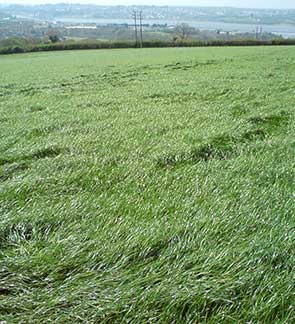IDEAL SUPREME Long-Term Herbal Mixture
IDEALSEED HERBS & HERBAL LEY’S – what to consider in selecting a mixture
There has been increasing interest in the use of herbal leys (also known as multi-species swards) for livestock farmers over the last few years. Summer/Autumn drought conditions appear to be more common and managing perennial ryegrass leys has become more challenging in our changing climate. Perhaps it is time to review what types of grass seed mixes best suit our climate and the additional benefits herbal leys can bring to livestock and production efficiency.
Herbal leys contain a variety of grasses, legumes and herbs and are much more diverse than the typical perennial ryegrass-based swards that we are used to. More diverse leys have several benefits, and these will depend on the species used:
Substantial Benefits on the Farm & for the Environment:
- Less need for purchased fertiliser due to nitrogen fixing properties of legumes (Herbs, white clover and lucerne).
- Higher protein content than pure perennial ryegrass swards, along with higher mineral and trace element levels.
- Deep rooting and so more resilient to drought. Deeper rooting species also help improve soil structure, aerating the soil and aiding drainage.
- Better soil health through improved carbon sequestration. More carbon is captured from the atmosphere and incorporated into organic matter in the soil.
- Less run-off as water can penetrate the soil more easily due to better soil structure.
Potential opportunity to extent the grazing season, with less of a grass growth peak in May and more growth in late summer. However, grazing during wetter periods can damage herbs so care must be taken to manage grazing in the shoulders of the grazing season to prevent sward damage.
Some species such as sainfoin and chicory have natural anthelmintic properties so potentially less need for wormers.
Supports pollinators like bees and butterflies by providing a food source (from flowering species).
Multi-species mixes can be sown in either spring/early summer, ideally when soil temperature is greater than 8°C with available soil moisture, or in late summer/early autumn (before the end of August). When sown later in the year there is less competition from grass, however, earlier sowing will mean better establishment and root development before winter for the herbs that struggle with frost.
The species included in a mix will depend on whether it is primarily to be used for cutting or grazing and what key functions you wish to achieve i.e., drought resistance, improved protein content, improved soil structure and/or increasing biodiversity. Soil type and geography will also influence the choice and a minimum of six different species is recommended to gain the benefits.
Considerations for grazing leys:
In the first year after sowing, lightly graze the ley to help control weeds and promote tillering to increase sward density.
Herbal leys are well suited to rotational grazing systems after the first year as rest periods help some species to last longer. Continuous grazing is likely to reduce the persistency of some species like legumes and herbs.
Avoid overgrazing and leave a residual of 7-10cm during the grazing season.
Considerations for cutting leys:
If designing a mix specifically for cutting, the species included will need to be able to withstand regular cutting, such as red clover, lucerne (best on high pH sandy soils), and plantain.
Chicory & Lucerne are best included in in grazing mixtures. It has a tough stem which can pierce silage bale wrap and goes to head quickly.
We Include species that grow at similar rates so that some slower growing species are not smothered by faster-growing ones.
Ideally, herbal leys should be down for four years to reap the benefits of nitrogen fixation, root growth and forage yield. Also, these mixes tend to be more expensive than ryegrass/clover mixes, and so the longer they can be maintained, the better the return on investment.
| Weight (Kg) |
Species |
| 2.50 |
Late Tet Perennial Ryegrass |
| 2.50 |
Late Tet Perennial Ryegrass |
| 0.75 |
Festulolium |
| 2.25 |
Sainfoin |
| 0.75 |
Timothy |
| 0.75 |
Meadow Fescue |
| 1.0 |
Red Clover |
| 0.5 |
Birdsfoot Trefoil |
| 0.25 |
Medium Leaved White Clover |
| 0.25 |
Small Leaved White Clover |
| 0.50 |
Ribwort Plantain |
| 0.10 |
Yarrow / Sweet Fennel |
| 0.50 |
Persian Clover |
| 0.70 |
Burnet |
| 0.20 |
Sheeps Parsley |
| 0.50 |
Perennial Chicory |
Optional without Perennial Chicory, by increasing the alternative herb contents
14.00 Kgs / Acre Pack







Reviews
There are no reviews yet.